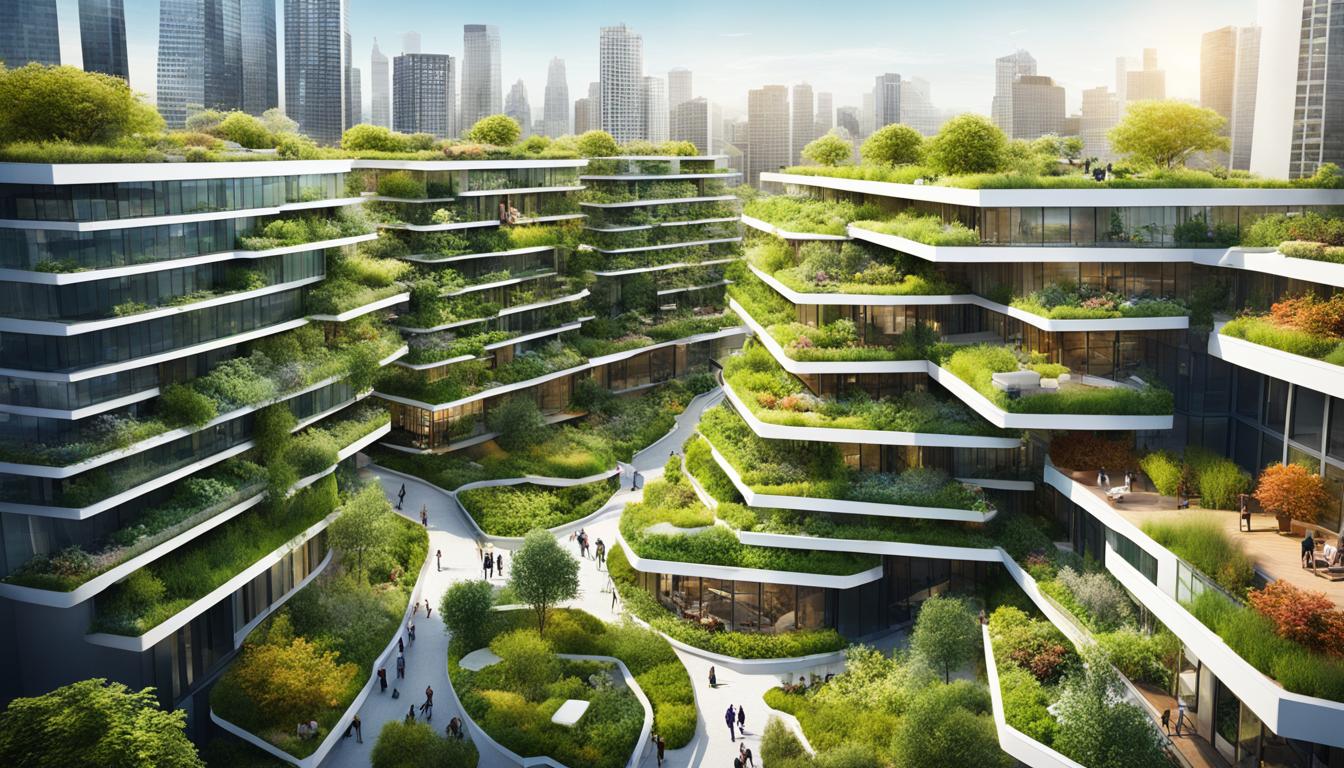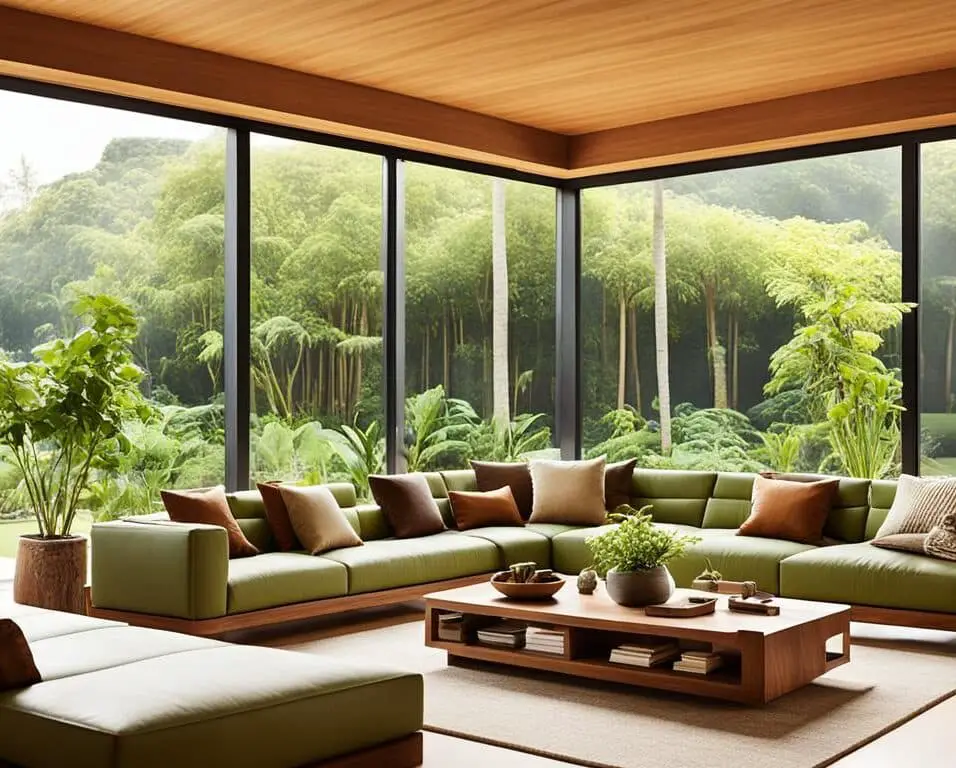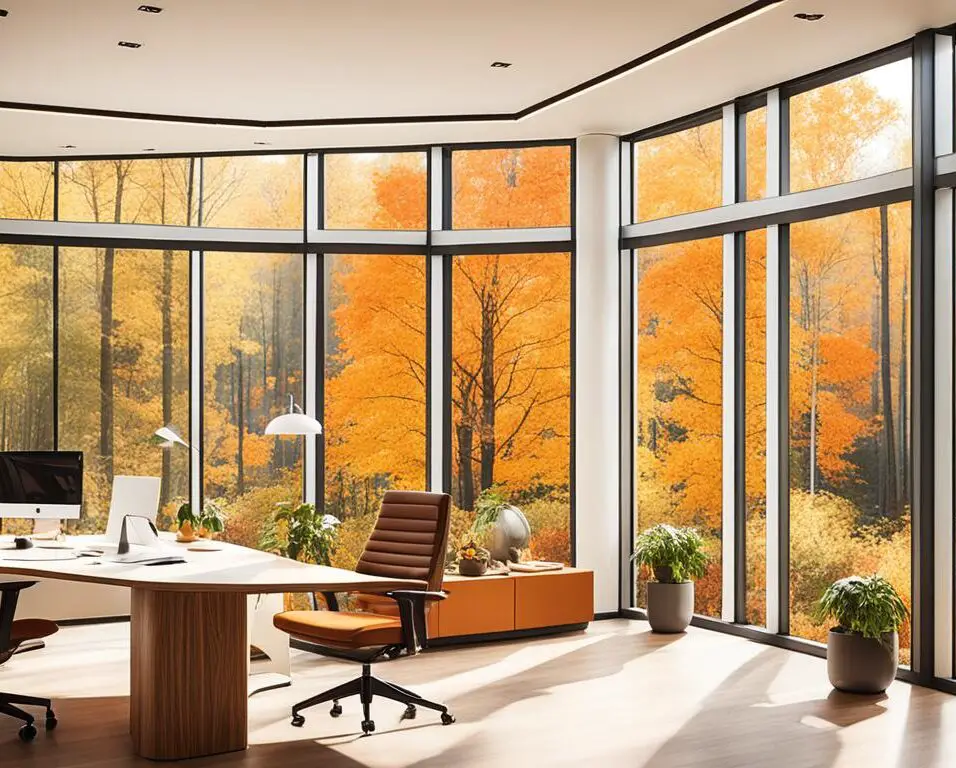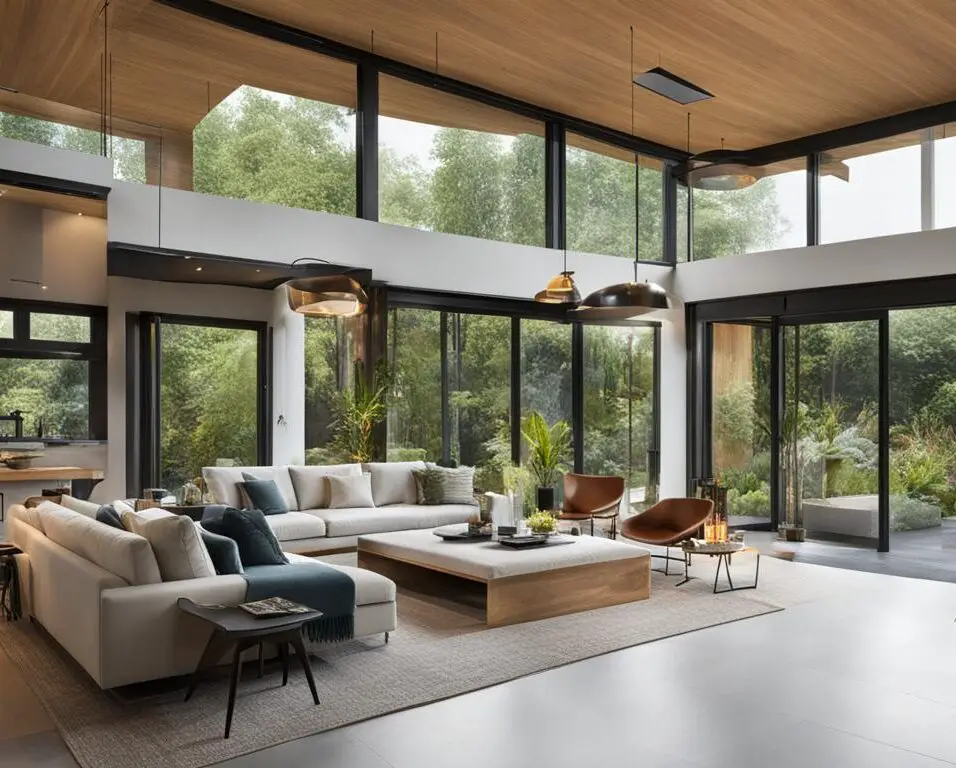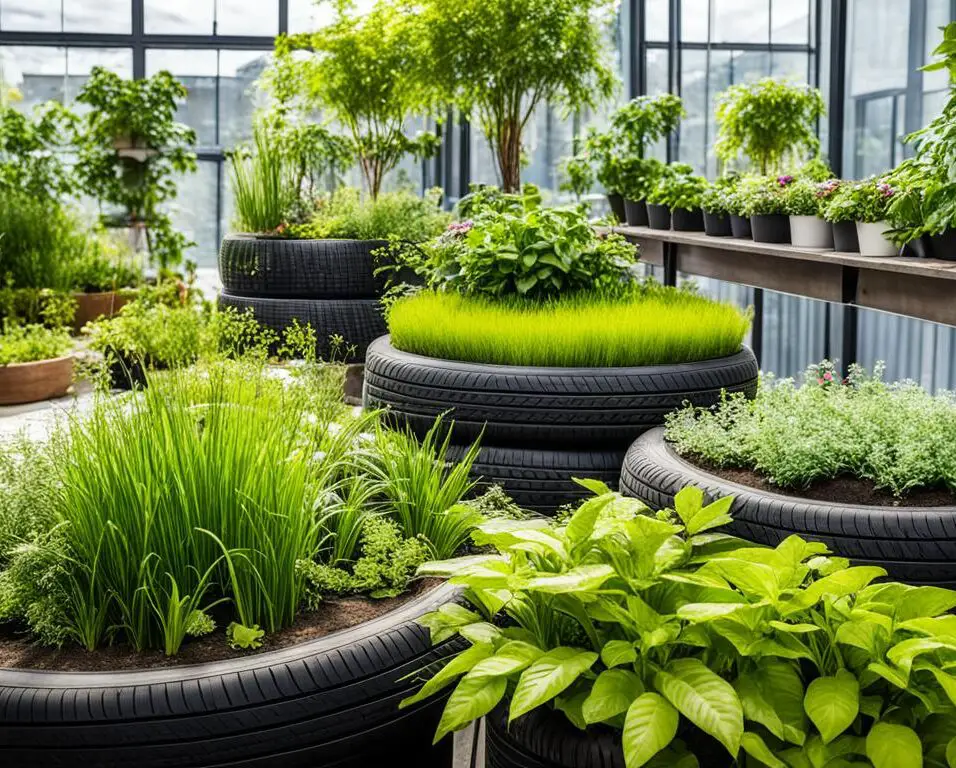Urban Jungle: Biophilic Design in High-Density Areas
As a journalist specializing in architectural trends, I am captivated by the concept of biophilic design. Biophilic design breathes life into high-density urban areas, transforming them from cold concrete spaces into lush, green havens that mimic the beauty of nature. This approach seeks to reconnect people with the natural world in the midst of the bustling urban jungle.
Biophilic design draws inspiration from the Fibonacci sequence and the golden ratio, which have long been used in art, design, and architecture to create balance and visual harmony. Architects and interior designers continue to incorporate these mathematical formulas to create modern interpretations of the Fibonacci sequence in their projects.
Key Takeaways:
- Biophilic design aims to incorporate natural elements into high-density urban areas, creating green havens amidst concrete spaces.
- The Fibonacci sequence and the golden ratio have been used in architecture to create visual harmony and balance.
- Green roofs and vertical gardens provide sustainable design solutions in urban areas, offering insulation, energy efficiency, and improved air quality.
- Pocket parks offer residents breathing spaces and opportunities for reflection in the midst of the urban jungle.
- Biophilic design philosophy goes beyond incorporating green spaces, aiming to create places that activate the senses and foster a deep connection to nature.
The Power of the Fibonacci Sequence in Architecture
When it comes to creating visual harmony and balance in architecture, the Fibonacci sequence and the golden ratio are powerful tools. Derived from a mathematical formula published by Leonardo of Pisa, these principles have been used by architects throughout history to create stunning and aesthetically pleasing structures.
The Fibonacci sequence, characterized by the pattern of adding the two previous numbers to obtain the next number (0, 1, 1, 2, 3, 5, 8, 13, 21, and so on), can be found not only in mathematical sequences but also in nature. From the spiral pattern of the nautilus shell to the arrangement of petals in flowers or the spiral growth of pinecones, the Fibonacci sequence can be seen in the intricate beauty of the natural world.
Architects like Leonardo Da Vinci and Le Corbusier were among the pioneers who incorporated the Fibonacci sequence and the golden ratio into their architectural designs. By applying these mathematical formulas, they were able to achieve a sense of balance and visual harmony in their masterpieces.
“Architecture is the learned game, the clear and noble premeditation of forms assembled in light.”
– Le Corbusier
One example of modern architecture drawing inspiration from the Fibonacci sequence is the educational center in Denmark. The building’s spiraling design, reminiscent of the Fibonacci spiral, creates a fluid and dynamic space for learning and exploration.
Another fascinating example is the treehouse in Spain, where the Fibonacci sequence is used to guide the design and construction. The branching structure of the treehouse follows the Fibonacci pattern, creating a visually striking and harmonious retreat.
The Fibonacci Sequence in Modern Architectural Projects
Here are some modern architectural projects that showcase the application of the Fibonacci sequence:
| Architectural Project | Location | Main Features |
|---|---|---|
| Education Center | Denmark | Spiraling design, inspired by the Fibonacci spiral |
| Treehouse | Spain | Branching structure following the Fibonacci pattern |
| Residential Complex | United States | Use of Fibonacci ratios in building proportions |
| Art Museum | Italy | Integration of Fibonacci numbers in the spatial layout |
Green Roofs and Vertical Gardens in Urban Areas
As urban areas continue to expand vertically, the integration of green roofs and vertical gardens is revolutionizing sustainable design in high-density cityscapes. These innovative solutions not only enhance the visual appeal of urban areas but also offer numerous environmental benefits.
The Power of Green Roofs
Green roofs, also known as living roofs or eco-roofs, are systems that incorporate vegetation and plant life onto the rooftops of buildings. This green infrastructure is designed to provide insulation, improve energy efficiency, and reduce the urban heat island effect.
By installing a layer of soil and vegetation on the roof, green roofs help to regulate internal temperatures, reducing the need for excessive air conditioning in hot climates and reducing heating requirements during colder months. As a result, buildings with green roofs experience significant energy savings, making them more environmentally friendly and cost-effective in the long run.
Beyond energy efficiency, green roofs also contribute to stormwater management by minimizing runoff. The vegetation and soil on green roofs absorb rainwater, reducing the strain on urban drainage systems and preventing water pollution. This sustainable approach to managing rainwater helps to alleviate the burden on municipal infrastructure and promotes a more sustainable urban water cycle.
Vertical Gardens: A Vertical Oasis
Vertical gardens, also known as living walls or green walls, are structures that incorporate vegetation directly onto vertical surfaces, such as building facades or freestanding walls. These gardens provide an aesthetically pleasing and environmentally beneficial solution to transform ordinary walls into vibrant tapestries of lush greenery.
One of the significant advantages of vertical gardens is their ability to improve air quality. Through photosynthesis, the plants in vertical gardens absorb carbon dioxide and release oxygen, reducing air pollution and enhancing overall air quality in densely populated urban areas. In addition, the vegetation acts as a natural filter, capturing particulate matter and purifying the surrounding air.
Vertical gardens also offer insulation benefits similar to green roofs by reducing heat absorption through the building’s walls. This energy-saving feature contributes to improved energy efficiency and a more comfortable interior environment.
Creating Sustainable and Vibrant Urban Spaces
By incorporating green roofs and vertical gardens into urban areas, architects and designers are able to create sustainable and vibrant spaces that have a positive impact on both the environment and the well-being of residents. These green interventions promote biodiversity, reduce the urban heat island effect, and improve air quality.
Moreover, green roofs and vertical gardens can enhance the overall aesthetic appeal of buildings, transforming monotonous concrete structures into natural havens that blend harmoniously with the surrounding environment. These green spaces have the potential to rejuvenate neighborhoods, create a connection to nature, and foster a sense of well-being among urban dwellers.
With their numerous environmental benefits and aesthetic appeal, green roofs and vertical gardens are essential elements of sustainable design in high-density urban areas. By embracing these innovative solutions, cities can take a significant step towards creating a greener and more livable future for their residents.
Pocket Parks: Breathing Spaces in the Concrete Jungle
In the midst of the bustling city streets, pocket parks offer a breath of fresh air for urban dwellers seeking respite from the concrete jungle. These strategically placed green spaces provide a much-needed connection to nature’s healing embrace, offering a sanctuary in the heart of the city.
Pocket parks are small, carefully designed green spaces that serve as tranquil oases amidst the chaos of urban life. They offer opportunities for reflection, relaxation, and social interactions, fostering a sense of community among residents. Whether it’s a quiet bench surrounded by lush foliage or a vibrant gathering spot with picnic tables, these green havens provide the perfect escape from the hectic pace of city living.
These miniature parks are designed to maximize the use of limited space, transforming unused corners or vacant lots into vibrant green spaces. They often feature trees, shrubs, flowers, and seating areas, creating a harmonious blend of nature and urban design. Pocket parks contribute to the overall well-being of urban communities, offering a retreat where people can recharge and reconnect with nature.
“In the midst of the bustling city streets, pocket parks offer a breath of fresh air for urban dwellers seeking respite from the concrete jungle.”
Studies have shown that spending time in green spaces has numerous benefits for physical and mental well-being. Access to nature in an urban environment has been linked to stress reduction, improved mood, and increased cognitive function. Pocket parks provide a convenient way for city residents to experience these benefits and enjoy the healing power of nature without having to venture far from their homes or workplaces.
Creating Green Connections in Urban Life
The concept of pocket parks aligns with the growing awareness of the importance of green spaces in urban planning and design. These miniature green havens not only enhance the visual appeal of the surrounding area but also contribute to the ecological balance of the city. They help mitigate the urban heat island effect, improve air quality, and provide habitat for urban wildlife.
Moreover, pocket parks have the potential to transform the dynamics of urban life by creating opportunities for social interactions and community engagement. They serve as gathering places for neighbors to connect, fostering a sense of belonging and shared responsibility. Events such as outdoor concerts, art exhibitions, or farmers’ markets can further activate these spaces, promoting a vibrant and inclusive community.
The Key Benefits of Pocket Parks:
- Access to nature in the heart of the city
- A peaceful retreat and source of relaxation
- Opportunities for social interactions and community engagement
- Eco-friendly solutions promoting biodiversity
- Improvement of mental and physical well-being
In an era where urbanization is rapidly transforming the landscape of cities, pocket parks provide a vital counterbalance to the concrete-dominated environment. They offer an escape from the stresses of urban life, a chance to reconnect with nature, and a glimmer of hope for a more sustainable and harmonious urban future.
Biophilic Design Philosophy: Where Nature Meets Architecture
Biophilic design is more than just the incorporation of green spaces into architecture. It is a philosophy that seeks to create spaces that deeply resonate with the innate human connection to the natural world. Through deliberate design choices, such as the use of natural light, organic materials, and views of greenery, biophilic design aims to activate our senses and remind us of our inherent bond with the land.
By integrating nature into architecture, biophilic design creates harmonious spaces that not only enhance our mental and physical well-being but also foster a profound connection to the natural environment. These spaces serve as a refuge from the fast-paced urban life, providing a sense of calm and tranquility amidst the hustle and bustle of modern cities.
“The spaces we inhabit should be a manifestation of our deep-rooted relationship with nature, allowing us to feel grounded and connected in our built environment.”
– Jane Thompson, Biophilic Design Architect
Biophilic design principles acknowledge the power of nature in positively influencing our emotional state, cognitive function, and overall quality of life. Through the thoughtful integration of elements such as indoor plants, natural textures, and water features, designers create environments that mimic and evoke the serenity of the natural world.
Enhancing Well-being through Biophilic Design
Studies have shown that exposure to nature, even in the form of simulated environments, can have significant positive effects on our well-being. Biophilic design, with its emphasis on connecting with nature, has been found to:
- Reduce stress and anxiety levels
- Improve cognitive function and productivity
- Promote physical health and healing
- Enhance creativity and innovation
- Foster social interaction and a sense of community
By consciously incorporating biophilic design principles into our built environment, we can create spaces that holistically support our physical, mental, and emotional well-being.
Examples of Biophilic Design in Architecture
Let’s explore some notable examples of biophilic design in modern architecture:
| Building | Description |
|---|---|
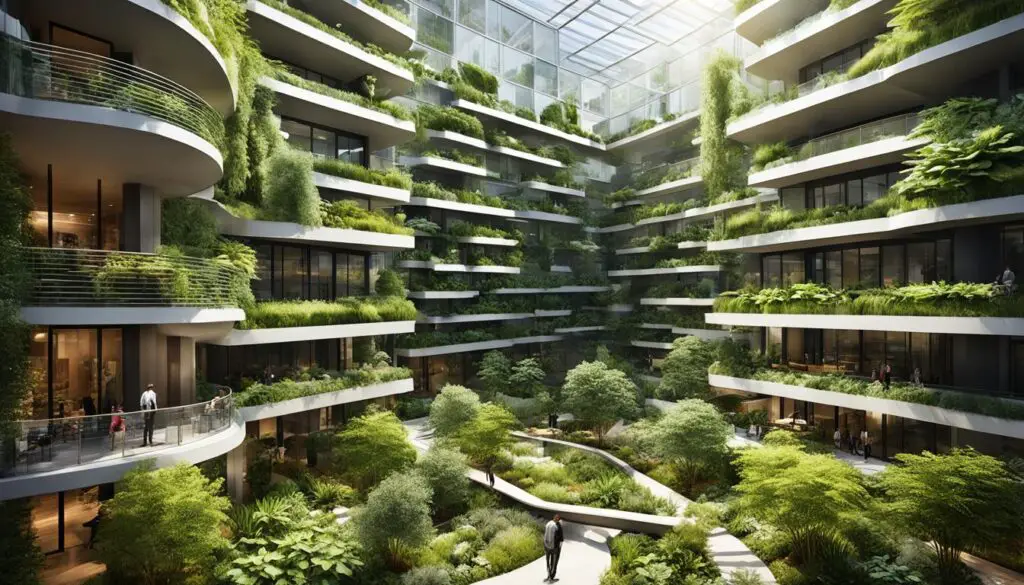 |
The Bosco Verticale in Milan, Italy, is a residential skyscraper that features a stunning vertical forest. The building is adorned with over 700 trees and more than 20,000 plants, creating a vibrant and sustainable living environment. |
 |
The Nk’Mip Desert Cultural Centre in Osoyoos, Canada, seamlessly blends with its desert surroundings. The building incorporates natural materials like wood and stone, and its architecture mimics the curvilinear forms found in nature. |
 |
The Gardens by the Bay in Singapore is an iconic example of biophilic design on a grand scale. This sprawling waterfront park combines lush gardens, sustainable technologies, and breathtaking architectural structures to create an immersive and captivating natural experience. |
These architectural marvels demonstrate the transformative power of biophilic design, showcasing how the integration of nature into urban environments can redefine our relationship with the built world and invigorate our senses.
Biophilic design is a testament to our deep-rooted connection with nature, reminding us of the beauty and serenity that the natural world offers. By incorporating biophilic principles into architecture, we can create spaces that nurture the human spirit and promote a harmonious coexistence between the built environment and the natural world.
Community Gardens: Cultivating Relationships and Plants
Community gardens provide a unique space where residents come together to cultivate, tend, and harvest plants. These green spaces not only offer opportunities for sustainable food production but also foster social interaction and a sense of shared responsibility among neighbors. By engaging in communal gardening, individuals can actively contribute to sustainable living practices while forming meaningful connections within their community.
Gardening in community spaces encourages individuals to embrace sustainable food habits by growing their own produce. This practice promotes self-sufficiency and reduces reliance on mass-produced food, which often involves high levels of pesticides and long transportation routes. By growing their own fruits, vegetables, and herbs, community gardeners have direct control over the quality and freshness of their food, allowing them to adopt healthier and more sustainable eating habits. The benefits of sustainable food production extend beyond individuals, positively impacting the environment by reducing carbon emissions associated with long-distance transportation and promoting biodiversity through the cultivation of diverse plant species.
Furthermore, community gardens offer more than just a source of fresh produce. They serve as gathering places, fostering social interaction among neighbors who may not have otherwise connected. As individuals tend to their plants side by side, they engage in conversations, share gardening tips, and develop friendships. The shared responsibility of maintaining the garden creates a sense of unity and belonging within the community. These social interactions strengthen community ties, breaking down barriers and creating a supportive network among neighbors.
Moreover, community gardens serve as educational spaces, allowing individuals to exchange knowledge and skills related to gardening and sustainable practices. Experienced gardeners can mentor newcomers, sharing their expertise and guiding them through the process of nurturing plants. This transfer of knowledge nurtures a sense of empowerment and self-reliance, building resilience within the community.
Community gardens provide opportunities for sustainable food production, foster social interactions, and cultivate a sense of shared responsibility among neighbors.
By creating and supporting community gardens, urban environments become transformed. Concrete spaces are replaced with vibrant pockets of greenery, providing numerous benefits to both individuals and the community as a whole. The inclusion of community gardens in high-density urban areas demonstrates a commitment to sustainability, social cohesion, and the preservation of nature’s beauty.
The Healing Power of Nature in High-Density Living
In high-density urban areas, green spaces possess a remarkable healing power, offering residents a sense of peace and rejuvenation amidst the bustling city life. The connection with nature has a profound impact on our well-being, reducing stress, enhancing cognitive function, and promoting overall health.
Research has shown that exposure to green spaces has significant therapeutic effects. Spending time in nature can lower cortisol levels, the hormone associated with stress, and increase the activity of natural killer cells that strengthen the immune system. The tranquil and serene environments of green spaces provide an escape from the constant demands and noise of urban living, allowing individuals to recharge and find solace in nature’s embrace.
Whether it’s a sprawling park or a small rooftop garden, green spaces serve as important havens in high-density areas. They offer a respite from the concrete jungle, providing an opportunity for residents to connect with the natural world and find tranquility in its beauty.
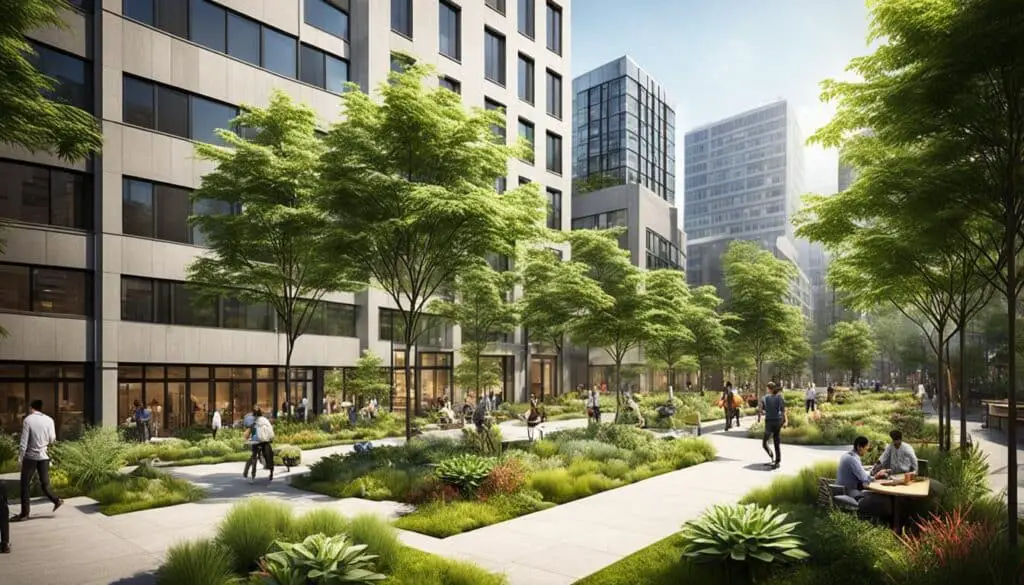
“In every walk with nature, one receives far more than he seeks.” – John Muir
John Muir, the renowned naturalist and advocate for nature conservation, eloquently captured the transformative power of nature. Green spaces provide a sanctuary for contemplation, introspection, and a communion with the natural world. Whether it’s taking a leisurely stroll, practicing yoga, or simply sitting under the shade of a tree, these spaces allow us to disconnect from the stresses of urban life and find harmony within ourselves.
Stress Reduction and Well-being
Living in high-density areas often entails long commutes, crowded spaces, and constant exposure to noise and pollution. These factors can have a detrimental impact on mental health and well-being. However, the presence of green spaces offers a counterbalance, providing a respite from the urban chaos and offering a range of mental health benefits.
- Stress reduction: Green spaces have been proven to alleviate stress and improve mood. Spending time in nature can help lower blood pressure and heart rate, leading to a sense of calm and relaxation.
- Improved cognitive function: Interacting with nature stimulates cognitive function, enhances attention span, and boosts creativity. It provides a much-needed break from the constant mental demands of urban living.
- Physical well-being: Green spaces encourage physical activity, such as walking and jogging, which contributes to improved physical fitness and overall well-being.
By integrating green spaces into high-density living, cities can create environments that support the physical, mental, and emotional well-being of their residents. These pockets of nature become essential elements in creating a harmonious and sustainable urban landscape.
Conclusion
Biophilic design has the power to transform high-density urban areas into sustainable and harmonious landscapes that prioritize the well-being of residents and the environment. By incorporating elements of nature such as green roofs, vertical gardens, and community gardens, architects and designers can create thriving, green environments that improve the lives of people living in the concrete jungle.
These green spaces not only provide aesthetic beauty but also offer numerous benefits. Green roofs, for example, provide insulation and reduce the urban heat island effect, contributing to energy efficiency. Vertical gardens improve air quality and transform plain facades into vibrant displays of vegetation. Community gardens not only encourage sustainable food production but also foster social interaction and shared responsibility among neighbors, strengthening the community bonds.
As urban areas continue to grow, it is crucial to integrate biophilic design principles to create a harmonious urban landscape. By bringing together the natural and built environment, we can create places that prioritize sustainable living and enhance the overall well-being of individuals and communities. The future of high-density urban living lies in the hands of architects, designers, and urban planners who embrace the potential of biophilic design and create a balance between the concrete jungle and the healing embrace of nature.
FAQ
What is biophilic design?
Biophilic design is a concept that aims to incorporate natural elements into high-density urban areas, transforming concrete spaces into lush, green havens.
How are the Fibonacci sequence and the golden ratio used in architecture?
The Fibonacci sequence and the golden ratio have been used in architecture to create visual harmony and balance. Architects like Leonardo Da Vinci and Le Corbusier have incorporated these mathematical formulas into their famous masterpieces.
What are the benefits of green roofs and vertical gardens in urban areas?
Green roofs provide insulation, energy efficiency, and a reduction in the urban heat island effect. Vertical gardens improve air quality and aesthetics, transforming drab facades into colorful tapestries of vegetation.
What are pocket parks?
Pocket parks are strategically placed green spaces in the midst of city streets that serve as breathing areas for residents to escape the concrete jungle and immerse themselves in nature’s healing embrace.
What is the philosophy behind biophilic design?
Biophilic design aims to create spaces that speak to the fundamental human connection to the natural world. It activates the senses by using natural light, organic materials, and views of greenery, creating harmonious spaces that improve mental and physical well-being.
What are community gardens?
Community gardens are common areas where residents come together to cultivate, tend, and harvest plants. They promote sustainable living practices and foster social interactions and a sense of shared responsibility among neighbors.
How do green spaces in high-density areas contribute to well-being?
Exposure to nature in the form of green spaces has been proven to reduce stress, improve cognitive function, and promote general well-being. These havens allow residents to escape the demands of city life and reconnect with the natural world.
What is the future of high-density urban living?
The future of high-density urban living lies in the integration of biophilic design principles, where the concrete jungle and the natural world converge. This approach creates sustainable and harmonious urban landscapes that improve the lives of residents and contribute to the overall well-being of the community and the environment.



